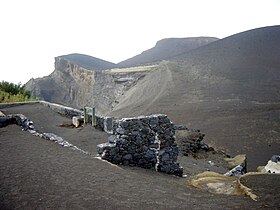Capelinhos
| Capelinhos | |
|---|---|

Capelinhos volcanic cone, as seen from Costa Nau and the ruins of the lighthouse
|
|
| Highest point | |
| Elevation | 501 m (1,644 ft) |
| Coordinates | 38°36′04″N 28°50′02″W / 38.601°N 28.834°WCoordinates: 38°36′04″N 28°50′02″W / 38.601°N 28.834°W |
| Geography | |
| Location | Faial Island, Azores |
| Parent range | Capelo Volcanic Complex |
| Geology | |
| Age of rock | between September 27, 1957 and October 24, 1958 |
| Mountain type |
|
| Last eruption | 1957 to 1958 |
The Capelinhos (from Capelo + -inhos diminutive, which literally means "little Capelos" or the "little cape") is a monogenetic volcano located on the western coast of the island of Faial in the Azores. It is part of the larger Volcanic Complex of Capelo, that includes 20 scoria cones and lava fields that are aligned west-northwest to east-southeast from the Cabeço Gordo caldera. Although the name "Capelinhos" is associated with the volcano, it technically refers to the western cape of the parish of Capelo. It can be considered the westernmost point of Europe, if the Monchique Islet, near Flores Island, also in the Azores, is considered part of insular North America, for it seats on the North American Plate.
A volcanic eruption lasted for 13 months, from September 27, 1957 until October 24, 1958, which may have been two overlapping volcanic eruptions. While enlarging the land by 2.4 km², it spawned 300 seismic events, hurled ash 1 km, destroyed 300 houses in the parishes of Capelo and Praia do Norte and caused the evacuation of 2,000 people (emigration to the US and Canada). On October 25, the volcano entered a period of dormancy. It is a part of an active fissural volcanic complex which creates multiple seismic and volcanic events.
Capelinhos is located along the Capelo Volcanic Complex, that comprises a western area of fissural volcanism and historical eruptions leading away from the Cabeço do Fogo. The events that began in 1957 were an extension of the volcanic activity that abruptly ended at Costado da Nau, the escarpment at Ponta dos Capelinhos. Similar to the Horta Platform, the peninsula is consistent with the shapes and products resulting from Surtseyan, Strombolian and Hawaiian volcanic types. The formation is composed primarily of basaltic rocks, although, less frequently, Hawaiian hawaiitic rocks are observed.
...
Wikipedia
